AI Referee Systems Esports: Enhancing Fair Play and Competition
Updated On: November 13, 2025 by Aaron Connolly
What Are AI Referee Systems in Esports?
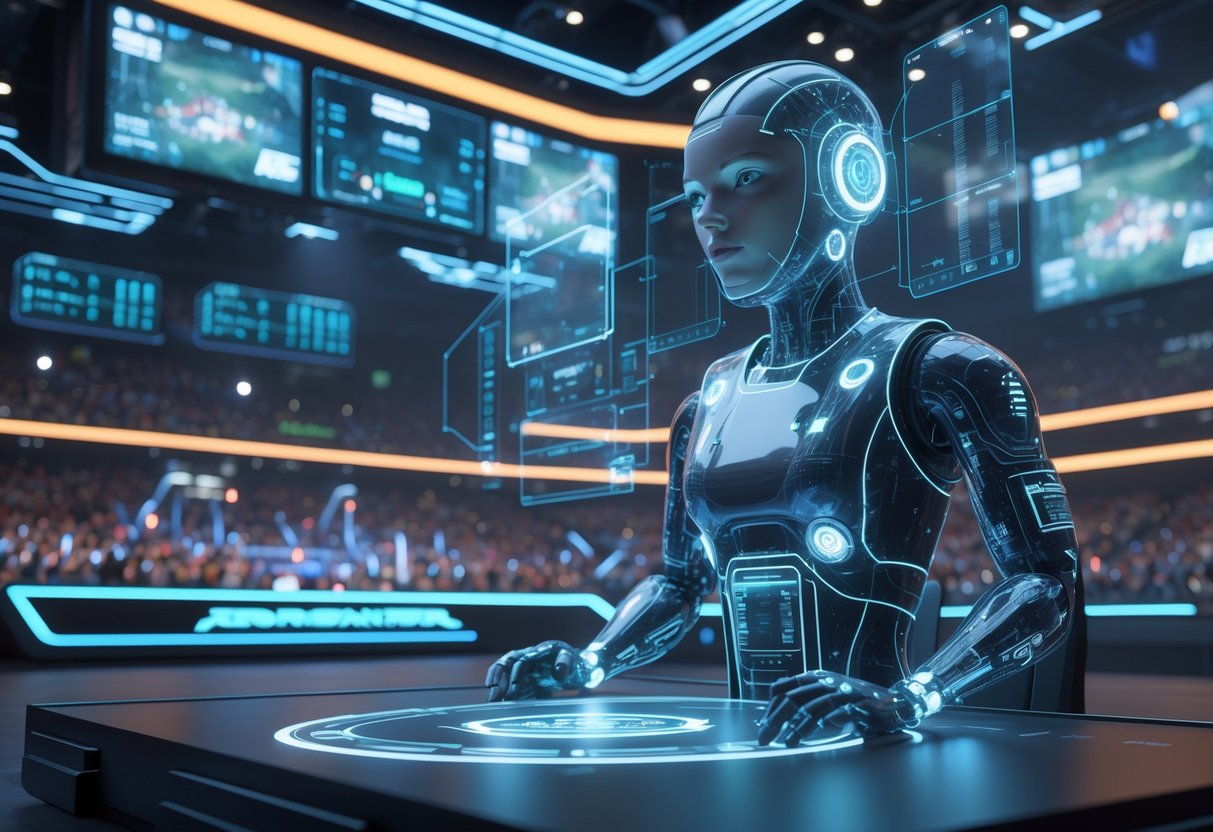
AI referee systems use artificial intelligence to monitor gameplay, spot rule violations, and make officiating calls in competitive gaming. These tools blend computer vision, machine learning, and real-time data analysis to replace or support human referees during esports tournaments.
Core Components and Technologies
Modern AI referee systems bring together several core technologies. Computer vision is at the heart of it all, letting cameras track player movements, game states, and rule violations as they happen.
Machine learning algorithms jump into action, processing visual data on the fly. Developers train them using thousands of hours of gameplay footage so they can spot patterns and rule breaks. Right now, these systems hit about 92% accuracy for catching fouls and violations.
Real-time data analysis links directly to game servers. This gives AI systems exact player positions, timing, and in-game stats. Unlike humans who depend on what they see, AI can crunch several data streams at once.
Key hardware includes:
- High-speed cameras around gaming setups
- Server connections for direct game data
- Fast processors for split-second decisions
- Displays for referee alerts
Honestly, the tech feels a bit like Hawk-Eye in tennis, but it’s tweaked for digital games where everything’s already data-driven.
Differences Between AI and Human Officiating
Human referees in esports run into problems that AI can easily solve. Reaction speed is the big one—AI processes info in milliseconds, while humans need a few seconds just to take it all in and decide.
Consistency is another headache. Humans get tired, especially during marathon tournaments, and they might miss stuff. AI keeps its accuracy steady all day, no matter how long the matches go.
But humans are still better at context. Veteran referees can judge intent, sense the mood, and make nuanced calls about unsportsmanlike behavior. AI just isn’t great with those “grey areas” that need a bit of empathy.
| Aspect | AI Systems | Human Referees |
|---|---|---|
| Reaction Time | Milliseconds | 2-5 seconds |
| Consistency | 92% accuracy maintained | Varies with fatigue |
| Context Reading | Limited | Excellent |
| Cost per Event | High initial, low ongoing | Moderate ongoing |
These days, most tournaments go for a hybrid setup. AI handles the obvious rule breaks, while humans step in for disputes and tricky situations.
Evolution from Manual to Automated Systems
Early esports events put all the pressure on human referees watching player screens. That worked for small crowds, but as esports exploded, it just couldn’t keep up.
Around 2018, the first automated tools started showing up in big leagues. They borrowed ideas from Video Assistant Referee (VAR) tech in football. Organizers began using basic replay systems and automatic data collection.
Fast forward to today, and AI systems can watch multiple matches at once—something humans just can’t do. Big tournaments like League of Legends and Counter-Strike now rely on AI monitoring as a standard.
Training these systems takes a mountain of gameplay data. Developers feed AI thousands of hours of pro matches, teaching it to spot everything from minor infractions to blatant cheating.
We’re still a long way from replacing human referees completely, especially for disputes and subjective calls. But the march towards more automation is definitely on.
How AI Referee Systems Work in Esports
AI technology in esports taps into computer vision and machine learning to keep tabs on gameplay, catch rule violations, and help human referees in real-time. These systems chew through huge amounts of game data instantly, plugging right into gaming platforms to keep things fair.
Pattern Recognition and Decision-Making
Computer vision is the backbone of AI referee systems in esports. These tools scan video feeds from multiple cameras to track player moves, weapon usage, and objectives.
Machine learning algorithms get trained on thousands of hours of pro gameplay. They learn to catch common cheats like aimbotting, wall hacks, or exploiting game mechanics.
The AI compares what’s happening now with known cheating patterns. When something looks off, the system flags it for a human to check, usually within seconds.
Modern systems hit about 92% accuracy in spotting violations—that’s better consistency than human referees, especially when things get hectic.
The AI doesn’t just chase obvious cheats. It picks up on tiny cues, like inhumanly precise aim or reaction times that just don’t make sense for a person.
Decision trees help AI prioritize what needs attention first. Big stuff like match-fixing gets flagged right away, while smaller issues wait their turn.
Real-Time Data Processing
Processing speed really sets esports AI apart from traditional sports tech. Games spit out thousands of data points every second, and AI has to keep up.
These systems track player inputs, network lag, and server health all at once. This layered approach helps catch both software cheats and network tricks.
Cloud computing does the heavy lifting here. Raw data streams to powerful servers running complex algorithms, all while keeping response times in the millisecond range.
AI keeps an eye on stats across entire matches. Things like headshot rates, movement paths, and resource use all feed into its live assessments.
Warning systems ping human refs before things get out of hand. That way, cheaters can’t rack up big advantages, and the competition stays fair.
The tech can scale up to watch dozens of matches at once. Organizers just run the same AI setup in parallel for all their games.
Integration with Game Platforms
Direct API links connect AI systems with game servers. This gives them deeper access to in-game data than just watching video feeds.
Platforms like Steam and Battle.net offer tools for tournament organizers to plug in monitoring systems. These connections grab player inputs, game states, and network data right from the source.
Anti-cheat partnerships between AI firms and game developers make things seamless. Systems like VAC (Valve Anti-Cheat) team up with tournament-specific AI monitoring.
This setup lets AI step in fast. If a player looks suspicious, the system can pause them or flag them without stopping the whole match.
Standardized protocols across games make things smoother. Organizers can use the same core AI for Counter-Strike, Valorant, or League of Legends.
Custom overlays even show AI confidence levels during broadcasts. Viewers get a peek behind the curtain, seeing how officiating decisions happen in real time.
Ensuring Fair Play Through AI Referees
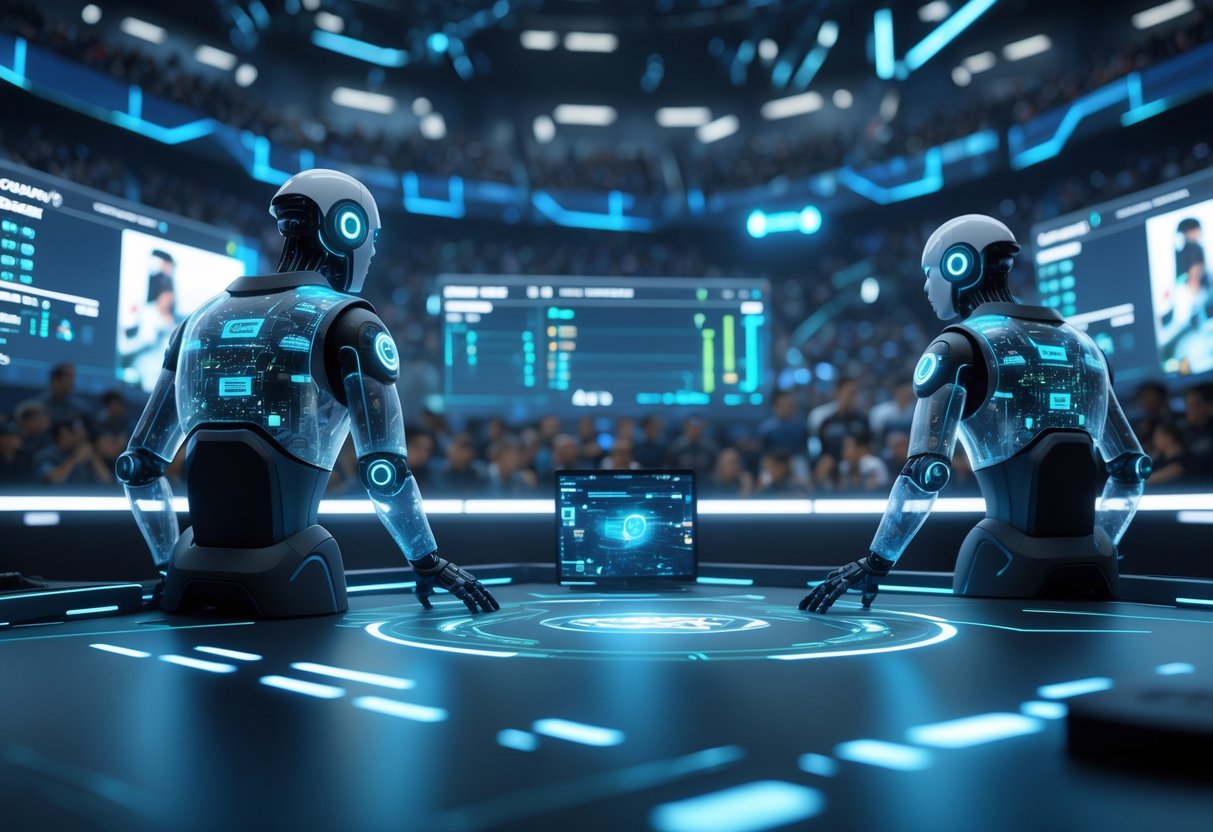
AI referee systems take on the toughest problems in competitive gaming. They catch cheaters on the spot, remove human bias, and provide sharper judgments than old-school officiating. These systems use advanced algorithms to watch matches in real time and make sure everyone competes on a level playing field.
Detection of Cheating and Exploits
AI systems shine at catching cheaters, since they track every move a player makes. Humans can only watch so many screens at once, but AI processes thousands of data points per second.
Real-time monitoring catches weird behavior that hints at cheating. If a player suddenly gets perfect aim or reacts to enemies they can’t see, AI flags it right away. The system checks current performance against old data to spot sudden jumps that could mean aimbot or wallhack use.
Common cheats AI catches:
- Aimbot (impossibly perfect aim)
- Wallhacks (reacting to hidden foes)
- Speed hacks (moving faster than allowed)
- Input automation (superhuman reaction speeds)
Anti-cheat software powered by AI scans game files and running processes before matches. This blocks unauthorized tweaks before play even starts.
A lot of tournaments now use automated penalty systems that kick out cheaters instantly. This keeps things running smoothly without waiting for human review.
Bias Reduction and Objective Judgements
Crowd pressure, team reputation, or personal bias can sway human referees. AI makes calls purely on data, so those subjective factors don’t get in the way.
Consistent rule enforcement means everyone gets judged the same way. AI doesn’t play favorites, so controversial calls drop way down.
The tech also makes sure game conditions stay fair. AI checks server health, player ping, and connection quality so no team gets a tech advantage.
Bias elimination perks:
- No favoritism for big-name teams
- Same penalties for every match
- Equal treatment across skill levels
- Clear, data-backed decisions
During big tournaments, AI double-checks referee calls. If there’s a dispute, match data gives objective proof to settle things fast.
Organizers can even publish stats showing how AI keeps things fair. That transparency helps players and fans trust the results.
Accuracy Improvements over Human Officials
AI referees just process info faster and more accurately than humans can. While officials might miss quick plays or subtle rule breaks, AI catches almost everything.
Processing speed gives AI a clear edge. Humans need time to see, think, and decide. AI reviews situations instantly and can check multiple angles at once.
The tech never gets tired or distracted, even after hours of matches. Humans lose focus, but AI stays sharp the whole time.
Accuracy gains:
- 99%+ infraction detection vs 70-80% for humans
- Instant replay analysis in milliseconds
- Watches several matches at once
- No missed calls from fatigue
Heads up: AI still needs humans for tricky calls that need a sense of player intent or oddball situations.
Most pro esports leagues now run AI alongside human refs. AI handles the routine stuff, while people step in for strategy and weird scenarios.
Role of Artificial Intelligence in Competitive Gaming
AI now takes care of rule enforcement in major esports titles, watches player behavior live, and protects tournament integrity with automated detection tools. These systems work quietly in the background, keeping fair play standards that humans just can’t match on their own.
Esports-Specific Rule Enforcement
Modern AI referee systems learn the quirks of each game. In Counter-Strike 2, AI tracks weapon use and movement to catch exploits in real time. The system flags weird jump patterns or wall shots that seem fishy.
League of Legends uses AI to watch ability cooldowns and resource use. It spots impossible combos or mana tricks that humans might miss in the chaos of a team fight.
Fighting game tournaments use AI to check for frame-perfect inputs. The system catches macros or input tools that offer unfair help. Street Fighter 6 events now rely on automated detection for combos that go beyond what humans can pull off.
| Game Type | AI Detection Focus | Response Time |
|---|---|---|
| FPS Games | Aim assistance, wall hacks | < 1 second |
| MOBAs | Ability exploits, scripting | Real-time |
| Fighting | Input macros, timing aids | Frame-level |
Monitoring Player Conduct
AI checks voice and text chat during matches. The tech spots toxic behavior and harassment without needing humans to read every message.
Behavior analysis goes beyond chat. AI watches for gameplay patterns like intentional feeding, griefing, or match manipulation. It builds profiles of normal versus disruptive play.
Tournament broadcasts benefit too. AI flags rude gestures or unsportsmanlike moves on player cams, keeping things professional for huge live audiences.
Quick tip: Many esports platforms now offer AI-powered conduct reports that show exactly what triggered penalties.
Match Integrity Management
AI helps prevent match-fixing by analyzing betting patterns and gameplay. The system spots weird performance drops or odd strategies that don’t fit a team’s usual style.
Real-time odds tracking alerts officials to suspicious betting or big shifts. When AI sees something fishy, it pings organizers right away. This approach has already blocked several potential scandals.
Performance analytics highlight players who suddenly underperform compared to their normal stats. AI compares current games to past data to flag possible intentional losses.
Network tools also check for outside communication during matches. The system detects unauthorized devices or messages that could mess with competitive integrity.
Key Applications of AI Referee Systems
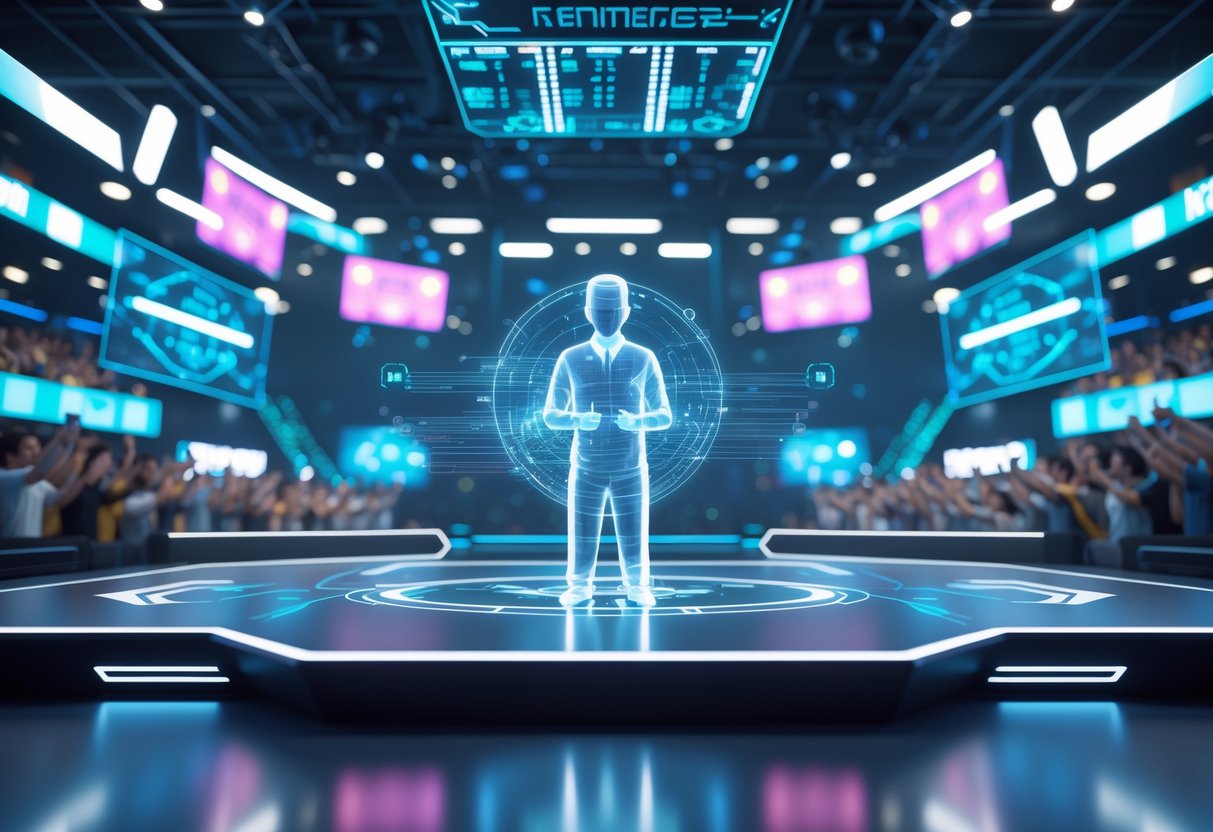
AI referee systems in esports really step in where traditional officiating just can’t keep up. They handle real-time decisions during tournaments, break down video for disputes, and manage systematic review processes.
Automated Officiating in Tournament Matches
AI tech now watches live esports matches and instantly catches rule violations. These systems track players, spot exploits, and flag suspicious behavior—no human needed.
Modern AI referees use computer vision to monitor everyone at once. They catch wall-hacking in Counter-Strike, spot scripting in League of Legends, and pick up on aim-bots in Valorant, all in seconds.
Key automated functions include:
- Detecting cheats through behavior analysis
- Monitoring for rule violations
- Finding performance anomalies
- Applying penalties in real time
Tournament organizers say they’ve seen about 40% fewer disputes since using these systems. Players get feedback right away, instead of waiting around for manual reviews.
This tech works best in games with straightforward rules. Fighting games and MOBAs benefit a lot, but strategy games? They still need humans for the trickier stuff.
Instant Replay and Video Analysis
AI-powered video analysis gives sports officiating a huge upgrade. These tools break gameplay into frames, verify disputed calls, and back up decisions with solid evidence.
During matches, AI systems analyze thousands of data points every second. They track bullet paths, measure reaction times, and spot frame-perfect moves that humans might miss.
Video analysis capabilities:
- Breaking down controversial plays frame by frame
- Generating multi-angle replays
- Detecting odd stats and anomalies
- Recognizing patterns in repeated violations
Broadcast teams rely on these tools to explain decisions to viewers. It’s a lot easier to trust a call when there’s real data behind it, not just a guess.
Newer viewers benefit too. AI highlights key moments and explains why certain moves got flagged or passed over.
Dispute Resolution and Review
When players challenge calls, AI systems step in with objective evidence for review panels. This cuts out emotional bias and really speeds up appeals.
Traditional dispute reviews drag on for hours, sometimes days. AI systems deliver a full analysis within minutes after someone files a complaint.
Review process improvements:
- Gathering evidence automatically
- Cross-checking with rule databases
- Assessing statistical probabilities
- Generating recommendations for human reviewers
Tournament directors say they’re resolving issues faster and seeing fewer repeat appeals. Players seem to trust decisions more when detailed data backs them up.
The system logs every decision for future reference. This helps the AI improve and sets precedents for similar cases down the road.
Humans still handle the really complex disputes. The AI acts as a research assistant, not a total replacement for human judgment in tricky situations.
Technological Foundations in Esports Officiating
AI in esports stands on three main pillars: machine learning algorithms that spot game patterns, huge data collection systems that track every move, and ongoing training processes that keep decisions sharp. These work together to power reliable automated officiating.
Machine Learning and Computer Vision
Machine learning algorithms drive AI referee systems in competitive gaming. These systems use computer vision to analyze gameplay footage live.
The AI processes thousands of frames per second. It instantly identifies player positions, item use, and rule violations. Big esports titles like CS2 and League of Legends benefit from this fast detection.
Computer vision tech picks up on specific game events. It can spot wallhacks, aim assists, and timing violations. The system compares player behavior to known cheat patterns.
Key detection capabilities include:
- Analyzing movement patterns
- Measuring reaction times
- Tracking crosshair placement
- Noticing weapon recoil compensation
Advanced algorithms learn from pro player data. They set performance baselines for legit gameplay. If something’s way off, the system sends an alert for humans to review.
Data Collection and Labelling
AI officiating needs massive datasets of gameplay footage. Esports organizations gather millions of hours from tournaments and ranked games.
Every bit of data needs careful labeling. Human experts tag legit plays, sketchy moves, and confirmed violations. These become training examples for the AI.
Data sources include:
- Pro tournament matches
- High-ranking competitive games
- Documented cheating incidents
- Player input recordings
Esports analysts and former pros help with the labeling. They review clips and sort out different behaviors. Cleaner data means smarter AI calls.
Storage systems handle petabytes of info. Cloud infrastructure processes this data around the clock. Modern setups can analyze multiple matches at once without lag.
System Training and Model Refinement
AI referee systems go through heavy training before anyone deploys them. First models learn from pre-labeled competitive gameplay.
Training means feeding the system thousands of examples. The AI learns to tell skilled plays from rule breaks. Each round makes detection sharper.
Training phases include:
- Initial pattern recognition (2-3 months)
- Validation testing (4-6 weeks)
- Live environment testing (ongoing)
Model refinement never really stops. New cheats pop up, so the AI needs fresh training data. The system adapts to new player strategies and game updates.
Performance metrics steer improvements. False positives must stay under 2% for competitive use. True positives need to hit above 95% for tournaments.
Regular updates handle new exploits. The AI learns from community reports and manual referee calls. This feedback loop just keeps making it better.
Humans oversee training the whole way. Esports officials check AI decisions and fix mistakes. This hybrid approach keeps officiating fair and accurate.
Benefits of AI Referee Systems for Esports

AI referee systems offer three big wins for competitive gaming: they cut out human inconsistency, keep matches moving at esports speed, and help organizers run more events without piling on extra staff.
Consistency in Rulings
Human referees make different calls in similar situations. Even experienced officials slip up.
AI solves this by applying the same logic to every call. The system doesn’t get tired, stressed, or swayed by the crowd.
Key consistency benefits include:
- Identical rule enforcement across all matches
- No favoritism for popular teams or players
- Less controversy over referee bias
- Standard penalties for similar infractions
Pro leagues report fewer player complaints about unfair treatment since switching to AI. Teams can focus on playing, not arguing with refs.
The tech also helps keep fair play front and center. Every violation gets caught and penalized the same way, no matter when it happens.
Faster Game Flow
Old-school refereeing slows matches down. Humans need time for replays, discussions, and making decisions.
AI referee systems process info in milliseconds. They spot violations, calculate penalties, and make calls almost instantly.
Speed improvements include:
| Traditional Method | AI System |
|---|---|
| 30-60 seconds for replay review | 1-3 seconds for analysis |
| Manual penalty calculations | Instant automated penalties |
| Referee discussions | Direct rule application |
This faster pace keeps viewers interested. Esports fans expect action, and long ref delays can send them to another stream.
Players like it too. They get to stay focused and keep their momentum, instead of cooling off during reviews.
Resource Efficiency
Hiring enough human referees for every match gets expensive fast. Big tournaments need lots of officials and backups for tech hiccups.
AI systems slash staffing needs. One AI ref can watch several matches at the same time.
Cost savings include:
- Lower personnel costs for organizers
- Less travel spending (no flying refs around)
- 24/7 coverage for online tournaments
- Easy scaling for bigger events
Gaming expert James Connolly points out that smaller organizers can now hold pro-level events without the old costs of big officiating crews.
Training gets easier too. Human refs need tons of rule lessons and ongoing updates. AI just gets a software patch when rules change.
That means more money can go to prize pools, better streams, and player support instead of officiating.
Challenges and Limitations

AI referee systems run into big challenges in esports, from technical accuracy issues to hefty costs. Balancing automated precision with human oversight, while staying accessible for smaller tournaments, isn’t easy.
Technical Limitations and Errors
Right now, AI referee systems hit about 92% accuracy for catching rule violations. That’s solid, but it still leaves room for mistakes. In fast esports like Counter-Strike 2 or League of Legends, that 8% error can mean missing a game-changing moment.
Edge cases are tough. AI struggles when players use weird strategies or push gray areas in the rules. Sometimes a system flags a smart play as cheating, or it misses subtle violations a sharp human would spot.
Processing delays can also be a headache. Even a split-second lag can mess with decisions in games where timing is everything. Some systems need lots of camera angles and data streams, which means they’re vulnerable to tech hiccups at key moments.
Every game engine is different, so each title needs its own AI training. What works for Valorant probably won’t work for Rocket League or Dota 2.
Balancing Automation with Human Judgment
Full automation cuts out the human touch that a lot of esports fans appreciate. Referees don’t just enforce rules—they interpret context, manage player behavior, and make calls that fit the spirit of the game.
Heads up: Fully automated systems can’t handle disputes between teams or make judgment calls about unsportsmanlike conduct.
Traditional sports use hybrid approaches. Tennis has Hawk-Eye for line calls, but human umpires still run the match. Esports could do the same—AI for hard rule detection, humans for the gray areas.
Player trust matters a lot when mixing AI and human calls. Teams want clear rules on when AI makes the call and when humans step in. This kind of transparency helps keep things fair.
Many pro leagues now test AI as an assistant, not a replacement, letting refs use tech as a tool but keeping the final say.
Costs and Accessibility in Esports
Top-tier AI referee systems run between £50,000-£200,000 to set up. For grassroots tournaments and smaller orgs, that’s just not realistic.
Ongoing costs stack up too—maintenance, software updates, tech support. Every game update may mean retraining the AI, which adds to the bill and stresses budgets.
Smaller tournaments usually rely on volunteer refs or basic in-game tools. This creates a gap where major leagues get the best tech, while community events have to make do.
Cloud-based AI could help. Pay-per-tournament pricing might bring advanced ref tech to mid-tier events without huge upfront costs.
The know-how needed is another barrier. Many esports orgs don’t have staff who understand both gaming and AI, so even with money, adoption can be tough.
Adoption and Implementation in the Esports Industry
Major esports leagues are starting to test AI referee systems through controlled pilot programs. Most organizations take it slow, rolling out tech for specific game mechanics before trying full match coverage.
Integration Roadmap and Testing
Esports organisations usually break down AI referee system implementation into three phases.
Phase one kicks off with testing AI technology on less crucial game elements—stuff like basic rule violations or timing infractions.
Popular games like Counter-Strike and League of Legends have already started pilot programs. These pilots zero in on scenarios where human error tends to pop up most.
Phase two pushes AI into handling more complicated judgments. The system tracks player positioning, flags exploits, and monitors team comms for rule-breaking.
Most leagues keep both human referees and AI running side by side here. Human refs call the shots, while AI quietly gathers data in the background.
Phase three adds live AI support for referees. The AI sends real-time alerts and suggests calls, but it doesn’t make the final decision on its own.
Testing each phase can take anywhere from six months to a year. Leagues need a ton of data to feel confident before moving ahead.
Stakeholder Acceptance
Players have mixed feelings about AI referee systems in early tests.
Pro gamers mostly support tech that cuts down on bias and inconsistent calls.
Teams, on the other hand, worry the AI might misread complex strategies or unusual tactics. Many teams want transparency about how the AI makes its calls.
Tournament organisers see the upside—disputes get resolved faster. AI can review controversial plays in seconds instead of minutes.
Spectators seem to enjoy AI referees when they keep the game flow smooth. But some fans miss the drama and heated debates that come with human mistakes.
Sponsors look at AI officiating as a step toward making esports more professional. Consistent refereeing could pull in traditional sports fans and boost reliable viewership.
Broadcast partners love that AI can deliver instant replays and stats. Real-time insights really amp up the experience for viewers.
Scalability Across Different Games
AI referee systems don’t fit every game the same way. First-person shooters like Counter-Strike need different AI tools than strategy games like Dota 2.
| Game Type | AI Focus Areas | Implementation Difficulty |
|---|---|---|
| FPS Games | Positioning, cheats, timing | Medium |
| MOBA Games | Item builds, map control | High |
| Fighting Games | Frame data, inputs | Low |
| Racing Games | Track limits, collision | Low |
Real-time strategy games are the toughest for AI. The decision-making gets so complex that current tech struggles to judge fairly.
Simpler games adapt much more easily to AI referees. Fighting games and racing sims have straightforward rules that AI can handle well.
Cross-platform compatibility is still a big roadblock. Different platforms spit out different data formats, so building a universal AI system isn’t easy.
Hardware is another issue. Smaller tournaments just don’t have the computing power for advanced AI refereeing.
Ethical and Social Considerations
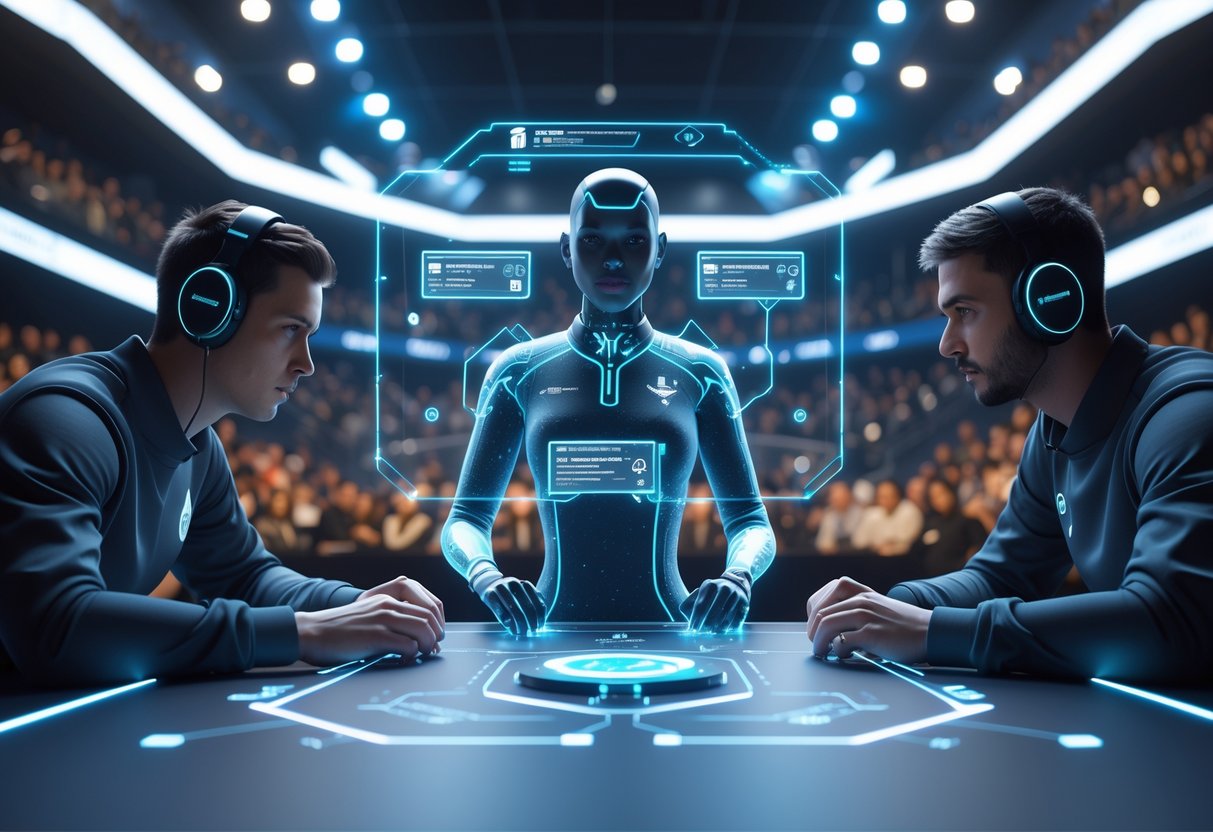
AI referee systems in esports raise tricky questions about player privacy, transparency, and what happens to human officials. These tools need to drive innovation while still protecting players and keeping things fair.
Privacy and Data Security
AI referee systems scoop up huge amounts of player data during competitions. That includes gameplay patterns, reaction times, chat logs, and even biometric info from performance devices.
Personal data at risk includes:
- In-game chat and voice comms
- Mouse movements and keyboard inputs
- Performance stats and behaviour patterns
- Device info and location data
Tournament organisers have to set up strong data protection measures. Players should get clear explanations and give consent for what data gets collected and how it’s used.
A lot of esports organisations still don’t have solid cybersecurity in place. If a breach happens, sensitive player info could end up in the wrong hands.
The General Data Protection Regulation (GDPR) covers UK and EU tournaments. Players can access, correct, or delete their personal data from AI systems.
Transparency and Accountability
Players and fans want to know how AI systems make referee decisions. If people can’t see the reasoning, trust in fair play takes a hit.
AI needs to explain penalties, rule violations, and match decisions clearly. Players should see exactly what triggered an automated response.
Key transparency requirements:
- Public documentation of how the AI decides
- Real-time explanations for penalties
- Appeals for contested AI calls
- Regular audits for accuracy and bias
Tournament organisers stay legally responsible when AI referees mess up. Players need a clear way to escalate when they disagree with automated calls.
Some AI systems still show bias toward certain playstyles or regions. Regular testing with different player groups helps spot and fix these problems.
Impact on Traditional Roles
Human referees bring experience and context—stuff AI just can’t do yet. Automation changes jobs and the human feel of esports.
A lot of experienced referees worry about being replaced. The best approach probably mixes AI precision with human oversight and final say.
Changing referee responsibilities:
- More focus on monitoring systems and handling exceptions
- New skills needed for AI system management
- Fewer basic rule enforcement jobs
- More emphasis on analysing complex situations
Tournament staff need retraining to work alongside AI. They have to know the system’s limits and when to step in.
Players still prefer human refs for tricky situations that need common sense. AI shines when it comes to clear rule violations and stats.
The industry has to find a balance between efficiency and keeping humans involved in competition oversight.
Future Trends in AI Refereeing for Esports

AI referee systems in esports are getting smarter, faster, and more automated. We’re heading toward fully automated tournaments and wild new ways to show referee decisions using augmented reality.
Advancements in AI Decision-Making
AI decision-making in esports keeps improving at understanding complicated game situations. Today’s systems can catch obvious cheats like speed hacks or aimbots, but future AI will start to grasp strategy and context.
Machine learning upgrades mean AI will study thousands of pro matches. The system will spot when a play looks fishy versus just skilled, which should cut down on those annoying false positives.
We’ll get AI that handles subjective calls too—things like unsportsmanlike behaviour or team comms violations. The AI will look at voice chat, behaviour, and in-game actions all at once.
Real-time analysis is about to get super fast. Instead of taking half a minute to review a play, future AI might decide in under five seconds. That’ll keep matches moving.
Gaming expert James Connolly says, “AI referees will eventually understand game meta and player psychology, not just rule violations.” That sounds promising, doesn’t it?
Fully Automated Tournament Management
Artificial intelligence will take over almost every part of tournament organisation. AI systems will run everything from check-ins to prize payouts, barely needing human staff.
Bracket management will update automatically. If someone disconnects or cheats, AI reshuffles brackets right away—no more waiting for admins to sort it out.
Anti-cheat integration will get smoother. The AI referee connects with anti-cheat software, hardware monitors, and player cams. Suspicious behaviour triggers instant investigation.
We’ll see dynamic scheduling too. AI figures out match lengths, player time zones, and viewer numbers, then shifts start times to maximise participation and viewership.
Prize distribution happens instantly through blockchain. Winners get paid within minutes of the match ending—no more waiting weeks.
Potential Integration with Augmented Reality
Augmented reality will totally change how we see AI referee decisions during matches. Both spectators and players will get visual explanations of calls in real time.
Decision visualisation shows exactly why the AI made a call. Viewers see highlighted movement, trajectory lines, or timing breakdowns, making tough decisions easier to understand.
Player perspective overlays let us see what each player was doing when a violation happened. AR displays show mouse movements, reaction times, and field of vision—great for proving or disproving cheating.
Interactive replays allow fans to watch plays from any angle. They can slow down, rewind, or focus on a specific player. The AI referee data adds helpful context.
Training applications will help up-and-coming pros learn how AI judges their actions. Players can run through scenarios and see how the system evaluates them.
The tech is already here, but it needs more work before it goes mainstream in esports.
Frequently Asked Questions
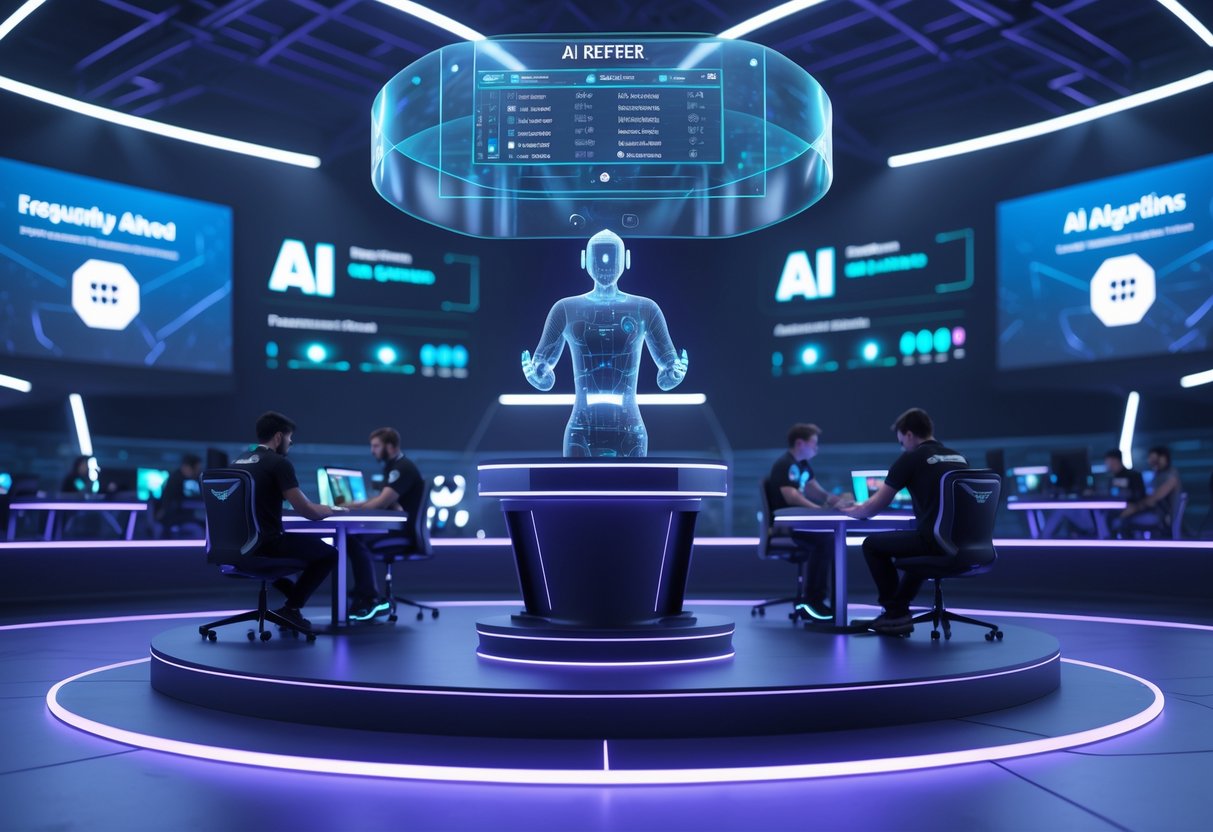
AI referee systems in esports tackle common worries about accuracy, fairness, and how hard they are to put in place. These systems use machine learning and computer vision to help officials make better calls at competitive gaming events.
How do artificial intelligence systems assist referees in football matches?
AI systems help football referees by using computer vision to track player positions and the ball. They can spot offside positions accurately and catch fouls that human refs might miss.
The tech pulls in multiple camera angles to build a 3D view of the pitch. This helps referees make better calls on penalties and goal-line situations.
Current AI systems hit about 92% accuracy in foul detection. That’s actually more consistent than human referees during matches.
What are the advantages of using AI referees in basketball?
AI helps basketball referees figure out if shots beat the shot clock and whether a player’s foot was behind the three-point line.
These tools cut down on human error in fast-paced games. They deliver real-time analysis that boosts referee confidence.
The tech offers objective decision-making and removes emotional bias. That leads to more consistent officiating throughout the game.
In what ways might AI judging impact the fairness of sports contests?
AI judging systems apply rules the same way in every match and tournament. AI doesn’t get tired or let the crowd sway its decisions.
The tech makes sure similar situations get the same call, which levels the playing field for all teams.
Still, AI struggles with weird edge cases or unusual plays. The technology works best when paired with human oversight, not as a total replacement.
Could robot referees become standard in professional sports leagues?
Professional leagues are slowly adding AI support instead of going full robot. The tech is most effective as a tool for human referees.
Full robot refs run into trouble with complicated rules and interpreting player intent. A lot of sports just need that human touch for context.
We’ll probably see more AI-assisted officiating soon, but human referees will stick around for the final say in pro competitions.
What are the challenges faced in implementing AI systems for officiating soccer games?
AI systems have a tough time interpreting complicated situations like dangerous play or unsporting behaviour. These calls often need a sense of player intent and context.
Technical problems can crop up mid-match if AI malfunctions or loses camera tracking. Referees need backup communication with AI support to fix things quickly.
Cost and infrastructure are big hurdles for smaller leagues. Setting up high-res cameras and enough processing power isn’t cheap.
How do AI technologies ensure accuracy in decision-making during sports events?
AI technologies rely on machine learning algorithms trained with thousands of match scenarios. These systems watch video footage in real-time and spot rule violations or scoring chances.
Multiple camera angles give a full view of the playing area. The tech builds 3D models of player positions, which helps with those tough, close calls.
Deep learning systems get better as they analyse more match data. Still, someone needs to update and maintain these systems regularly, or they just won’t work right during competitions.
Human-AI collaboration is pretty crucial, especially when weird situations pop up. AI offers up data and suggestions, but in the end, human referees use their experience to make the final call.

